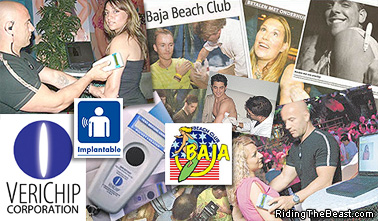How can I boast such claims? Simple. Radio frequency identification (RFID) implants are currently the prime candidate for this beastly technology. These tiny wonders are already being implanted in the body to be used as a form of payment [6].
* "Beautiful club-goers have a problem: If you're going to wear a halter top and micro-skirt, there's not much of anywhere to put a wallet. And who wants to carry a purse when you're there to dance? Luckily, a company called VeriChip this year unveiled a solution based on radio-frequency identification (RFID) technology. It's a slender glass capsule ... a computer chip, which stores a unique code that can identify an individual — sort of an electronic Social Security number." Get chipped, then charge without plastic -- you are the card
 Verichips
are implanted in the upper arm of patrons at the Baja Beach Club in
Barcelona, Spain. Along with the Baja Beach Club is The Rotterdam Beach
Club in the Netherlands, and the Bar Soba in Glasgow, Scotland, all who
have successfully introduced the Verichip microchip implant as a form
of payment.
Verichips
are implanted in the upper arm of patrons at the Baja Beach Club in
Barcelona, Spain. Along with the Baja Beach Club is The Rotterdam Beach
Club in the Netherlands, and the Bar Soba in Glasgow, Scotland, all who
have successfully introduced the Verichip microchip implant as a form
of payment.More about RFID implants and the Verichip
RFID, which stands for Radio Frequency IDentification, is currently making leaps and bounds as a replacement for the common barcode. RFID is also being hyped as the next big thing in personal identification. There are two types of RFID microchips (a.k.a. tags or transponders) in development, passive and active.
The barcode replacements and current versions of the Verichip implant are passive transponders. A passive transponder requires an outside source of energy to activate. A burst of energy within a close distance (usually a few inches) charges the microchip enough to respond with whatever information is stored on it. In the case of the Verichip, that information is a 16 digit identification number which is then cross referenced against a database for unlimited amounts of information.
Commercial devices are coming to market which will be surgically implanted and require some sort of power supply. This is nothing new, consider the pacemaker. The big difference though is that a pacemaker runs on batteries, and batteries need to be replaced. Replacement requires another costly operation, which inherently involves risk. The point of an internal renewable power supply is that the batteries will never have to be replaced.
There is already existing technology that provides a
means of creating an electrical current through the process of
temperature change. The Mark of the Beast is said to be in the hand or
forehead and it's no surprise that these are prime areas for hot and
cold changes.
Thermo Life [7][8],
owned by Applied Digital Solutions through it's purchase of eXI
Wireless, is a technology that converts temperature change into
electricity. Consider the following:"This next-generation Thermo Life™ is a direct result of VeriChip Corp's acquisition of eXI Wireless. Knowing that the acquisition was in the process, our research and development personnel aimed to improve the Thermo Life™ product to provide a potential power source for an active RFID tag for People." Scott R. Silverman, Chairman and CEO of Applied DigitalThermo Life is a permanent power supply that operates off temperature fluctuations in the human body. One of the main advantages of a powered (active) RFID implant is to allow for tracking. In fact, Applied Digital Solutions is currently hard at work incorporating GPS into their Verichip for the allowance of global tracking [9]. Thermo Life will likely power these devices. The name alone is reminiscent of eternal hell fire, exactly what partakers of the Mark of the Beast can look forward to.
Applied Digital Solutions has already been successful in marketing and developing external devices that track people at small and large scales. Their Hugs and HALO products track newborns while in the hospital. RoamAlert and WatchMate are external devices used for security or "Wander Prevention."
 Verichip Corp's implantable products include VeriMed, VeriGuard, [10]
and VeriPay. RoamAlert also comes in an implantable version. Verichip
Corp recently pulled all references to their VeriPay product [11]. They have been known to remove specific references to their products only to have them resurface when the time is right [12].
Verichip Corp's implantable products include VeriMed, VeriGuard, [10]
and VeriPay. RoamAlert also comes in an implantable version. Verichip
Corp recently pulled all references to their VeriPay product [11]. They have been known to remove specific references to their products only to have them resurface when the time is right [12].Not long ago their VeriKid [13] product tracked children in urban environments, but they have also since pulled this product, likely until the market is able to accept it more readily. It was easy to see the similarities between VeriKid and the Mark of the Beast.
The tracking doesn't stop at geographic location either. Heart rate, breathing, temperature, sleep, and consciousness can all be monitored from any remote location [14]. All of this is already being used in real world applications.
No comments:
Post a Comment